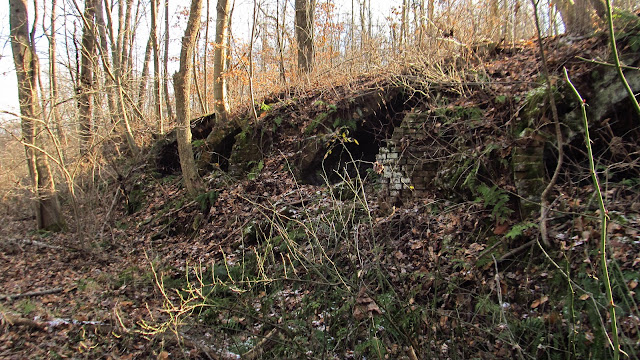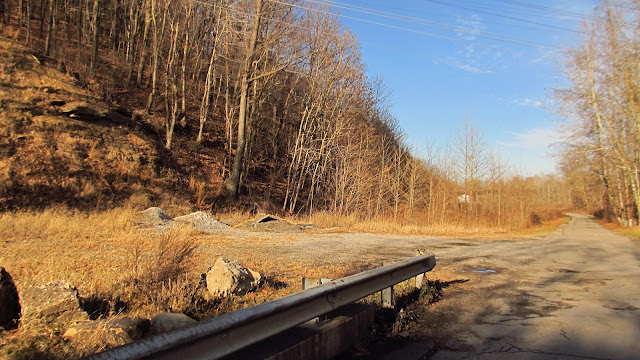I'm kind of coming to the end of the remaining coke ovens in the old Connellsville Coke District. It's been about five years and I have done somewhere around 135 coke plants. It has to be a Guinness record. I'm now picking up some odds and ends and there's still a few left. Juniata is one I have looked at many times and just never did it. It looked easy, it sits right off the road, there's a nice clearing where high tension power lines pass over the ovens, but that creek. I wasn't expecting the stupid little creek. I beat it though.
It turned out to be a pretty cool site. The history is interesting as well. The ovens date back to 1890 and were constructed for the Juniata Coke Company. It wasn't until 1891 that everything was up and running. The Juniata Coke Company was another Cochran concern. The company was based in Dawson and had its headquarters in the National Bank Building, right in town. I'm pretty certain the only plant they operated was this one, under this name anyway. Juniata Coke Company would operate the plant until August 1, 1908, when Frick scooped it up for $150,000. When Frick bought it, however, the mine was nearly worked out. All that remained were a few stumps and ribs. Frick bought it for the purpose of securing an outlet for another large tract of coal he held in that neighborhood. He would operate it until at least 1921. The Frick influence had already been in place by 1904, U.S. Steel is listed at having half ownership with Juniata holding the other half in that year. I'm assuming the $150,000 was just buying Juniata's half but that's still a lot to pay for an empty coal mine.
 |
By October 1890 everything was starting to take shape as reported in the October 17, 1890 Connellsville Courier. |
 |
By January 1891, 25 of the ovens were ready to go. January 9, 1891 Connellsville Courier. |
 |
Also in January 1891, Cochran was working on bringing trolley service to link some of the towns he either owned or had mines at. Massillon Independent January 19, 1891. |
In October 1901 Juniataville made national news when a father and his two sons met a horrible death in an abandoned air shaft leading to a worked out section of the mine. This is from the Philadelphia Inquirer October 14, 1901.
 |
The part saying Gilleland worked at the mine for more than 25 years must be a typo. The mine would have only been open around 10 years at this point. |
 |
On October 7, 1917 more tragedy struck Juniata. Warren Morning Chronicle October 8, 1917. |
This is what's left there now:
 |
This is the view from the road. The sun was really working against me all day so bear with me. |
 |
This is what's left of the block. It looks like one of the piers that held the weight of the larry cars remains. |
 |
A little section of the front wall. |
 |
These are all of the bank. |
 |
They're all in pretty bad shape. |
 |
This is all debris in the area where the trains would have been loaded. |
 |
Back to the bank. |
 |
A small portion of the retaining wall remains between these two ovens. |
 |
The area between the bank and the block. |
 |
Huge piles of coke ash. |
 |
The old railroad grade. |
After this I went down to look for the Wheeler Coke Works. There wasn't anything left but there were still some nice stone railroad structures. This area was a crazy hub of railroad activity.
 |
A 1900 Uniontown Quad map showing the area with the ovens visible at Wheeler. |
 |
1931 Uniontown Quad showing how much this area exploded with railroad activity. Wheeler is no longer even listed. |









































Mike, great pictures!!! It always amazes me to see these deserted places and then consider how much activity occurred there, thousands of people building and operating these facilities, huge amounts of capital expended, lives lost. And now.....quiet.
ReplyDeleteThanks Paul! I think it's amazing too. It's just insane how many of these places there were/are.
DeleteA Great presentation Mike. My grandpap worked at those ovens in 1899 and I enjoyed seeing and reading about them very much. Bill
ReplyDeleteWondering if you have any info on the houses in Juniata? Do any pictures of the original town exist?
ReplyDeleteAs a girl I grew up in Juniata.There is alot of original houses left.All became privately owned.My grandfather bought the double house.My grandparents lived on one side,my parents lived on the other.My father said each double house cost 1000dollarsI think the miners had first chance to buy them.My grandfather worked in the Juniata ille mine
ReplyDeletethey recently logged all the trees in and around the coke ovens at juniata all the ovens can plainly be seen from road no more trees
ReplyDelete